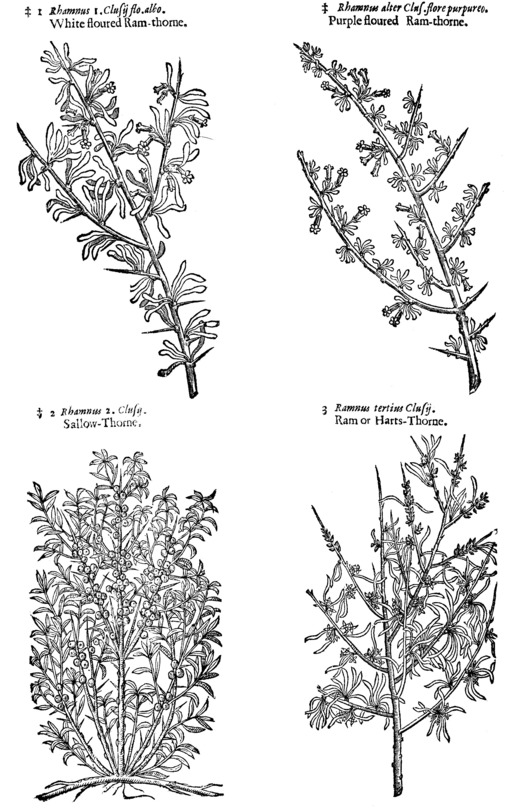
Gerard's Herbal Vol. 5
The Kinds.
After the opinion of Dioscorides there be three sorts of Rhamnus, one with long, flat & soft leaves: the other with white leaves, and the third with round leaves, which are somewhat blackish. Theophrastus and Pliny affirm that there are but two, the one white, and the other black, both which do bear thorns: but by the labour and industry of the new and late writers there are found sundry sorts more, all which and every one of them are plants of a woody substance, having also many straight twiggy and pliant branches, set with most sharp pricking thorns.

Fig. 1895. Kinds of Ram or Hart's Thorn (1-3)
The Description.
1. This is a shrub growing in the hedges, and bringing forth straight branches and hard thorns, like to those of the Hawthorn, with little leaves, long, something fat and soft: and this hath that notable learned man Clusius described more diligently in these words: the Ram is a shrub fit to make hedges of, with straight branches, parting itself into many twigs, white, and set with stiff and strong thorns, having leaves, which for the most part grow by fours or fives at the root of every thorn, long, something fat, like to those of the Olive tree, somewhat white, but tender and full of juice; which in autumn do sometimes fall off, leaving new growing in their places: the flowers in autumn are something long, whitish, divided at the brims into five parts: in their places is left a seed, in show as in Gelsemine: notwithstanding it was never my chance to see the fruit: the root is thick and diversly parted.
I observed another (saith the same author) almost like to the former, but lower, and divided into more branches, with lesser leaves, more thick and salt of taste, and whiter also than the former: the flowers are like, in all things but their colour, those of the former, which in this are purple.
2. This hath more flexible stalks and branches, and these also set with thorns: the leaves are narrow, and not so thick or fleshy as those of the former, yet remain always green like as they do: the flowers are small and mossy, of a greenish colour, growing thick about the branches, and they are succeeded by a round fruit, yellowish when it is ripe, and remaining on the shrub all the winter: The whole shrub looks as if it were sprinkled over with dust.
3. To these may be added another growing with many branches to the height of the Sloe tree or Blackthorn, and these are covered with a blackish bark, and armed with long prickles: the leaves, as in the first, grow forth of certain knots many together, long, narrow, fleshy, green, and continuing all the year: their taste is astringent, somewhat like that of Rhubarb: the flowers show themselves at the beginning of the spring, of a greenish colour, growing thick together, and near the setting on of the leaves; in summer it carries a black fruit almost like a Sloe, round, and harsh of taste.
The Place.
The first of these grows in sundry places of Spain, Portugal, and Provenše: the other variety thereof Clusius saith he found but only in one place, and that was near the city Orihuela, called by the ancients Orcellis, by the river Segura, upon the borders of the kingdom of Valencia: the second grows in many places of Flanders and Holland, and in some valleys by rivers sides. The third grows in the untilled places of the kingdom of Granada and Murcia.
The Time.
This Ram is evergreen together with his leaves: the fruit or berries remain on the shrub, yea even in winter.
The Names.
The Grecians call this Ramnos: the Latins also Rhamnus; and of divers it is also named Spina alba, or Whitethorn, Spina cervalis, or Hart's-thorn, as we find written among the bastard words. Marcellus nameth it Spina salutaris and Herba salutaris, which hath, saith he, as it were a grape. It is called in Italian Marruca and Rhamno: in Spanish, Scambrones: in English, Ram, or Hart's-Thorn.
The Temperature.
The Ram, saith Galen, doth dry and digest in the second degree, it cooleth in the later end of the first degree, and in the beginning of the second.
The Virtues.
A. The leaves, saith Dioscorides, are laid poultice-wise upon hot choleric inflammations, and Saint Anthony's fire, but we must use them whilst they be yet but tender, as Galen addeth.
B. The leaves and buds or young shoots of the first are eaten as salads with oil, vinegar, and salt, at Salamanca and other places of Castile, for they have a certain acrimony and acidity which are grateful to the taste. A decoction of the fruit of the third is good to foment relaxed and weak or paralytic members, and to ease the pain of the gout, as the inhabitants of Granada told Clusius.